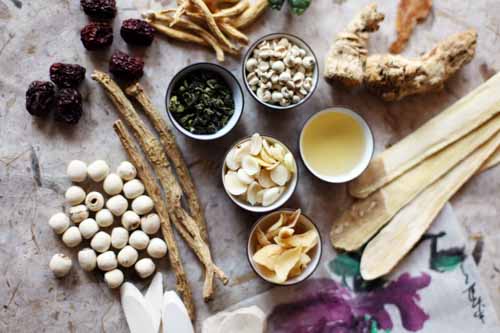Blood Stasis in the Respiratory System
Sample of Online Materials

Sample
Xue Fu Zhu Yu Tang Overview
Xue Fu Zhu Yu Tang is a Qing dynasty formula introduced by Dr. Wang Qing Ren in his Yi Lin Gai Cuo (Correcting Errors in the Medical Forest) about 300 years ago. Xue Fu Zhu Yu Tang is based on Tao Hong Si Wu Tang and is modified with Qi regulating herbs.
Ingredients of classic Xue Fu Zhu Yu Tang
Chi Shao (Radix Paeoniae Rubrae) 2-12g
Dang Gui (Radix Angelicae Sinensis) 3-12
Chuan Xiong (Radix Ligustici Chuanxiong) 3-9g
All the herbs above promote blood circulation. The herbs can be differentiated as follows: Chi Shao cools blood heat. Dang Gui nourishes the Blood. Chuan Xiong moves the Qi in the Blood and tends to flow to the body surface and upper body.
Hong Hua (Flos Carthami Tinctorii) 3-9g
Tao Ren (Semen Persicae) 3-12g
Hong Hua and Tao Ren both break congealed blood. Hong Hua’s action is faster as well as stronger. Tao Ren’s action is more sustained for a longer period of time and it is able to moisten dryness.
Niu Xi (Radix Achyranthis Bidentatae) 3-12g
Niu Xi promotes blood flow downward to the legs, strengthens the Liver and Kidney, and expels wind-damp Bi pain.
Sheng Di Huang (Radux Rehmanniae Glutinosae) 3-15g
Sheng Di Huang cools blood heat, nourishes the Blood, and moderates the Blood regulating function of the stronger blood regulating herbs.
Chai Hu (Radix Bupleuri) 3-6g
Zhi Ke (Fructus Citri Aurantii) 3-12g
Jie Geng (Radix Platycodi Grandiflori) 3-15g
All the above herbs regulate Qi. Chai Hu regulates Liver Qi and promoting its flow upward and horizontally in the body. Zhi Ke opens the chest and descends the Qi. Jie Geng regulates Lung Qi, opens the Lungs and guides the herbs to the upper body.
Zhi Gan Cao (Honey-Fried Radix Glycyrrhizae Uralensis) 3g
Zhi Gan Cao harmonizes the herbs in the formula.
Sample of Course Material From An Additional Section:
Chronic Bronchitis
Syndrome: Cough, asthma, shortness breath, white or yellow phlegm, fatigue, teeth marks, red or purple tongue with white or yellow greasy coating. Slippery, floating and rapid pulses.
Treatment Strategy: Expel cold or phlegm, open the Lung and promote Qi and blood circulation.
Base formula: Xue Fu Zhu Yu Tang modified with San Zi Yang Qin Tang and Xiang Sha Liu Jun Zi Tang.
San Zi Yang Qin Tang and Xiang Sha Liu Jun Zi Tang ingredients
(Zi) Su Zi Perillae Frutescentis Fructus 12g
Bai Jie Zi Semen Sinapsis Albae 12g
Lai Fu Zi Semen Raphani Sativi 12g
Su Zi, Bai Jie Zi and Lai Fu Zi dissolve phlegm. Su Zi stops cough. Bai Jie Zi penetrates through the phlegm. Lai Fu Zi reduces the food stagnation to open the middle jiao.
Chen Pi Pericarpium Citri Reticulatae 9g
Sha Ren Fructus Amomie 9g
Chen Pi and Sha Ren regulate Stomach and Spleen Qi and descend Stomach Qi. Chen Pi dries and regulates Qi and phlegm more than Sha Ren. Sha Ren is aromatic and has a strong fragrance to penetrate to a deeper level.
Dang Shen Radix Codonopsitis Pilosulae 15g
Bai Zhu Rhizoma Atractylodis Macrocephalae 15g
Fu Ling Sclerotium Poriae Cocoa 30g
Gan Cao Radix Glycyrrhizae Uralensis 3g
Si Jun Zi Tang formula: Dang Shen strengthens the Spleen Qi. Bai Zhu dries the dampness. Fu Ling drains and leaches the dampness from the middle jiao. Gan Cao harmonizes their function.
Qi, Phlegm and Blood Stagnation Modification
Xing Ren Pruni Armeniacae, Semen 3-12g
Ma Huang Herba Ephedrae 3-12g
Chuan Bei Mu Bulbus Fritillariae Cirrhosae 3-30g
Jie Geng Radix Platycodi Grandiflori 3-12g
All the herbs above stop coughing. Xing Ren, Ma Huang and Jie Geng open the Lung. Xing Ren and Ma Huang stop asthma. Xing Ren moistens the Lung and Ma Huang is stronger to stop asthma and it also promotes urination and causes sweating. Jie Geng guides the herbs to the upper body. Chuan Bei Mu moistens the dryness and stops dry cough.
Chen Pi Pericarpium Citri Reticulatae 3-9g
Ban Xia Pinelliae Rhizoma Preparatum 3-9g
Chen Pi and Ban Xia dry phlegm and descend Stomach Qi. Chen Pi regulates the Spleen and Lung Qi. Ban Xia dries phlegm and descends the Stomach Qi.
Fu Ling Sclerotium Poariae Cocoa 3-30g
Fu Ling promotes urination to drain the dampness from the Upper and middle jiao and balance the water in the body.
(Zi) Su Zi Perillae Frutescentis Fructus 12g
Bai Jie Zi Semen Sinapsis Albae 12g
Lai Fu Zi Semen Raphani Sativi 12g
Su Zi, Bai Jie Zi and Lai Fu Zi dissolve phlegm. Su Zi stops coughing. Bai Jie Zi penetrates through the phlegm. Lai Fu Zi reduces food stagnation to open the middle jiao.
Chen Pi Pericarpium Citri Reticulatae 9g
Sha Ren Fructus Amomie 9g
Chen Pi and Sha Ren regulate Stomach and Spleen Qi and descend Stomach Qi. Chen Pi dries and regulates Qi and phlegm. Sha Ren aromatically penetrates in a deeper level. Chen Pi has a faster effective action and Sha Ren is maintained in the bloodstream longer.
Dang Shen Radix Codonopsitis Pilosulae 15g
Bai Zhu Rhizoma Atractylodis Macrocephalae 15g
Fu Ling Sclerotium Poriae Cocoa 30g
Gan Cao Radix Glycyrrhizae Uralensis 3g
Si Jun Zi Tang: Dang Shen strengthens the Spleen Qi. Bai Zhu dries the dampness. Fu Ling drains and leaches the dampness from the middle jiao. Gan Cao harmonizes.
Dan Shen Radix Codonopsitis Pilosulae 3-12g
Chi Shao Radix Paeoniae Rubrae 3-12g
Chuan Xiong Radix Ligustici Chuanxiong 3-9g
Hong Hua Flos Carthami Tinctorii 3-9g
All the herbs promote blood circulation. Dan Shen cools the heat and calms the Heart. Chi Shao cools the heat and has a strong promote blood circulation function. Chuan Xiong flows fast and to the surface and moves the Qi in the blood. Hong Hua breaks up congealed the blood.
Chai Hu Radix Bupleauri 3-6g
Zhi Ke Fructus Citri Aurantii 3-12g
Qing Pi Pericarpium Citri Reticaulatae Veride 3-12g
All the herbs regulate Qi. Chai Hu spreads the Liver Qi. Zhi Ke and Qing Qi break Qi stagnation and descend Qi downwards. Zhi Ke opens the chest. Qing Pi emphasizes breaking Qi stasis and pain stagnation.
Sample
Table of Contents of Online Course Materials
Xue Fu Zhu Yu Tang Overview
Treatment Principles
Respiratory System Disorders
Treatment with Xue Fu Zhu Yu Tang
Pleurisy
Qi and Phlegm Stagnation Modification
Qi and Blood Stagnation Modification
Case Study 1
Case Study 2
Chronic Bronchitis
Qi Phlegm and Blood Stagnation Modification
Damp Heat with Qi and Blood Stagnation Modification
Qi and Yang deficiency Modification
Case study 1
Case study 2
Asthma
Excess Qi and Phlegm Stagnation Modification
Qi and Yang Deficiency Modification
Excess External Wind Attack Modification
Hot Phlegm Modification
Excess Wheezing Modification
Case study
Emphysema
Excess Qi and Phlegm in the Lungs Modification
Hot Phlegm Modification
Qi and Yang Deficiency Modification
Case study
Hemoptysis
Excess Bleeding Modification
Hot Phlegm Modification
Qi Deficiency Modification
Heat in the Blood Modification
Qi Level Heat Modification
Case study 1
Case study 2


